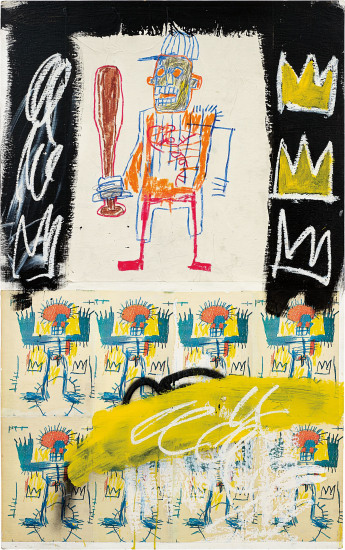Basquiat's childhood was marked by turmoil: his parents divorced when he was a teenager, his mother was often institutionalised, and his father was violent. Jean-Michel, with his extremely sensitive personality, ran away from home, wandering the streets of New York. He absorbed everything around him, storing concepts and ideas that he later expressed in his works. One of his greatest sources of inspiration was sport, a deeply rooted element in contemporary American culture.
For the African American community, sport transcended mere entertainment or professional aspiration. It provided global visibility to an oppressed community. "Famous Negro Athletes" was one of Basquiat’s early works where his artistic genius merged with the sporting universe. Initially graffiti, these works featured essential, decisive traits—a frenetic succession of lines forming recognizable elements like a baseball, the iconic three-pointed crown, and human faces in black, white, or both colours. The half-white, half-black faces symbolised social denunciation, highlighting how Afro people were only seen as equals after sporting success. The baseball symbol critiqued sport as the sole means of emancipation, with careers in art, management, or politics still a distant dream in the 1980s.
Jackie Robinson: A Sporting Icon
Jackie Robinson, who expressed his ideas and demonstrated the strength of the black community through baseball, became a true icon for Basquiat. "Untitled," one of Basquiat’s most famous sports-themed works, is dedicated to Robinson. In this piece, Robinson is sanctified, with an audience of adoring angels and the iconic crown symbolising his impact. Basquiat was fascinated by baseball, where individual actions could determine the match's outcome. Robinson, the first African-American player in the MLB, represented change and was seen as a Christ-like figure for the African-American sporting world. Justice, equality, and fraternity—Catholic values—were central to understanding Basquiat's choice of Robinson as a subject.

Revolutionising Baseball Cards
Basquiat was an experimenter, giving new life to everyday objects. His collaboration with Jennifer Stein on "Anti-product Baseball Cards" aimed to reinvent mass-produced baseball cards. Faces and biographies were erased, transforming each card into a unique work of art. This loss of identity was crucial, turning simple cards into non-products, unique artworks derived from commercial seriality.

Boxing: Fighting for Respect
Boxing has long been a popular sport among working-class children, offering a path to discipline, respect, and potentially a way out of poverty. For many kids growing up in challenging environments, boxing gyms provide a sanctuary from the streets, a place where they can channel their energy and frustrations into something constructive. The sport’s appeal lies in its accessibility—one doesn't need expensive equipment or facilities to start boxing, just a pair of gloves and the will to fight.
Basquiat’s admiration for boxing heroes like Joe Louis and Muhammad Ali reflects this connection. These athletes, who rose from humble beginnings to achieve greatness, embodied the resilience and determination that Basquiat saw in himself and those around him.

In 1981, he created "The Ring," depicting himself triumphant in the ring, arms raised in victory, symbolising his artistic and social success. Basquiat's heroes, such as Cassius Clay, Jack Johnson, and Sugar Ray Robinson, were African-American icons who fought racism with their gloves. His works dedicated to these boxers were surprisingly essential, with only a few decisive strokes capturing their essence, immortalising their feats.
Basquiat’s connection to boxing extended to his artistic endeavours. His brushstrokes were as decisive as a jab, his social messages as impactful as a powerful punch. His friendship with Andy Warhol led to a staged boxing match during preparations for a joint exhibition, capturing the essence of boxing, art, and their camaraderie.
Basquiat’s portrayal of boxers reflects the complex interplay of victory and vulnerability, embodying the spirit of those who fight not just in the ring but in life. His works celebrate the resilience of the working class and the indomitable spirit of those who rise above their circumstances. Through his art, Basquiat immortalises the struggles and triumphs of boxers, making their battles a powerful symbol of endurance and hope.
Jesse Owens, who shattered records at the 1936 Berlin Olympics, inspired Basquiat’s "Dark Race Horse." The work depicted an anatomical detail of Owens, symbolising his defeat of Nazi propaganda and the power of the African-American athlete in challenging racial ideologies.
Football: Power and Vulnerability
In the NFL, Basquiat was drawn to the helmet, representing both the athletic power and vulnerability of African Americans. "Untitled (Football Helmet)" played on these concepts, highlighting the need for protection from societal racism despite their on-field prowess.

Basquiat's artistic, cultural, and social legacy is boundless. The Brooklyn Nets honoured this by incorporating his style into their home arena and "city edition" uniforms. NBA star Kevin Durant cited Basquiat as a great inspiration, reflecting the indissoluble bond between Basquiat and sport. His art immortalises the athletes he portrayed, glorifying their successes and continuing the African-American community’s fight against racism and social inequality. Like the medals achieved by these athletes, Basquiat’s art remains timeless and immortal.
Discover Jean-Michel Bassquiat prints for sale and contact sales@andipa.com or call for further information.